LOSTCIRCUITS |
SHORTCUTS:
Top Page
Setup and
Performance
Discussion
Please
Give Us Some Feedback |
Carbon Black
Black
is Beautiful |
| (Review by MS, October 7, 2003) |
 Methodological Considerations
Methodological Considerations
One thing that needs to be made very clear from the beginning is that the
values that we show are by no means accurate in terms of absolute temperatures.
Each mainboard, within certain margins will translate the read-out from either
the thermal sensors or else from the CPU's own thermal diode in a somewhat
different way. In addition, we know that different BIOS revisions will change
the read-out as well even if the hardware remains identical. In so far, we are
stuck here really with comparing apples and apples or rather the same apple
under different lights.
Likewise, there is no way to
actually substitute any external measurement for the read-out of the on-die
diode. Admittedly, the sensitivity of the diode by far exceeds the actual
temperatures as measured in the socket or at the base of the heatsink but that
is exactly what we are looking for: a super-sensitive measuring device that
blows up differences "out of proportions" but is capable of showing these
differences - as long as they exist.
Pressure Considerations
Carbon Black performance is strongly dependent on the pressure applied on the
material. Below 100 psi, the compression is not sufficient to enable optimal
conductivity of the carbon particles. We measured the amount of pressure
required to disengage the bracket of the Thermalright SLK800 to be around 45
lbs, which translates into a pressure of roughly 90 lbs of the heatsink onto the
processor's die of 108 mm2. Corresponding
metrics are 42 kg/cm2 or ~4.1 MegaPascal or ~
600 PSI. To the best of our knowledge, performance of AS is not
pressure-dependent as long as there is enough pressure to warrant good contact.
Layer Thickness and Surface
Unless both surfaces are perfectly mirror polished, there will be grooves and
"striations" from the machining process that, as established in numerous lapping
articles, are the main source of insufficient transfer - unless good thermal
interface material is used.
The Thermalright SLK800 does not fall into the mirror-polished category but
for practical purposes, this is just what we need for a proof of concept.

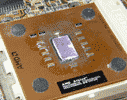
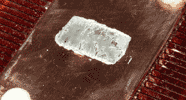
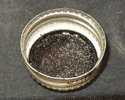
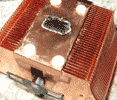
Top row: Arctic Silver Céramique imprint on both CPU die and bottom of the
cooler. In reality, the residual film with the crescent-shaped striations is
only a haze, however, the oblique angle of the flash brings out the coverage and
makes it look much thicker than it really is.
Bottom row: Arctic Silver Original forms a relatively thick TIM layer which
is a known issue that has been resolved with ASIII. AS - Carbon Black emulgate
(a bottle screw top is a perfect mixing bowl) note the "inhomogeneous"
consistency of the emulgate. Right: "print" on the heatsink after disassembly.
The "Céramique" photographs show rather clear what is going on. The
striations result in different thickness of the TIM meaning that both thermal
conductance AND spreadability will play a major role. In addition, the ridges
between the grooves are posing enough mechanical resistance to prevent a high
pressure build-up in the material within the grooves, that is, the highly fluid
Carbon Black will either escape to the sides or else just reside as a filler,
albeit, without the pressure required to build up enough conductance and contact
with the "host" surfaces.
Arctic Silver, on the other hand is simply too viscous to allow optimal
spreadability of the TIM between the two surfaces. The emulgate on the other
hand will have a two-fold effect, which is first, to block the "channels" and
therefore prevent the leakage of Carbon Black, second, in areas of increased TIM
thickness, the higher thermal conductance of AS will bridge the distance more
sucessfully than Carbon Black by itself. Conversely, suspension of AS particles
within the Carbon Black carrier, reduces the AS viscosity. and allows the
formation of a thinner transfer layer.
One additional effect of the suspension could be that the elastic and
compressible Carbon Black provides a better filling also in between AS
particles.
"Céramique" by Arctic Silver still gave the overall best performance which is
consistent with an extremely fine grain compound with high thermal conductivity.
Notwithstanding these findings, Carbon Black turned out to provide similar
performance as Arctic Silver for a fraction of the price. On the other hand, a
heterogeneous suspension of highly conductive metal particles in Carbon Black
may improve the thermal transfer between uneven surfaces.
If we had used two mirror polished surfaces against each other, we would have
predicted a better performance of Carbon Black.
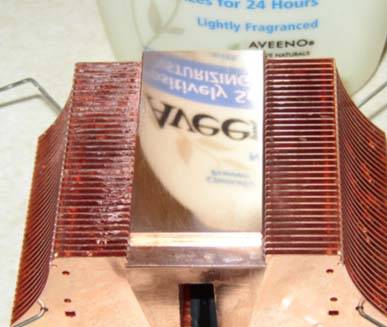
Stay tuned for Carbon Black "Part 2"
<= back
General disclaimer: This page only
reflects the author's personal opinion and assumes no responsibility whatsoever
regarding any of the contents or any damages that may occur explicitly or
implicitly from reading the contents of this site. All names and trademarks
mentioned in this review are the exclusive property of the respective parent
companies.
All contents of this site
are protected by international copyright laws. Reproduction of the contents even
in parts is not allowed except after written permission by the author and
referral to this site.
Copyright 2002 - 2005 LostCircuits 





